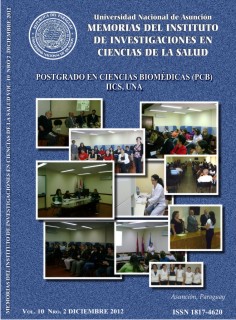Detección molecular de infecciones múltiples en mujeres con y sin lesión de cuello uterino positivas para el virus del papiloma humano de alto riesgo, período 2007-2011
Palabras clave:
infecciones múltiples, virus del papiloma humano, captura híbrida II, carga viral relativaResumen
El cáncer de cuello uterino, causado por el virus del papiloma humano (HPV), constituye el tercer tipo de cáncer más común en mujeres en el mundo. El objetivo del presente trabajo fue determinar por reacción en cadena de la polimerasa seguida de hibridación reversa, la frecuencia de infecciones múltiples en mujeres positivas para HPV de alto riesgo oncogénico por captura híbrida II, según severidad de la lesión escamosa intraepitelial (SIL), carga viral relativa y edad, en el periodo 2007-2011. Este estudio de corte transverso incluyó 123 mujeres que acudieron al Instituto de Investigaciones en Ciencias de la Salud, 18 sin lesión (NSIL), 78 con SIL de bajo grado (LSIL) y 27 con SIL de alto grado (HSIL). Se detectaron infecciones múltiples en 37/123 mujeres (30,1%). Las mujeres con NSIL presentaron menor frecuencia de infecciones múltiples (5,6%) que las mujeres con SIL (34,3%) (p=0,03). No se observó aumento de frecuencia de infecciones múltiples con la severidad de la lesión, presentando las mujeres con LSIL un 34,6% y con HSIL, un 33,3%. No fue observada diferencia significativa entre la carga viral relativa de infecciones simples y múltiples, lo cual sugiere que en la infección múltiple podría ser solo uno de los tipos de HPV el que se esté replicando, causando una infección productiva. Además, se observó una alta frecuencia de infecciones múltiples (75%) en mujeres menores a 30 años. Finalmente los resultados sugieren que las infecciones múltiples podrían orientar la presencia de SIL, pero no el grado de severidad de la lesión cervical.
Descargas
Citas
Walboomers JMM, Jacobs MV, Manos MM. Human papillomavirus is a necessary cause of invasive cervical cancer worldwide. J Pathol. 1999;189:12-29.
Ferlay J, Shin HR, Bray F, Forman D, Mathers C, Parkin DM. Estimates of worldwide burden of cancer in 2008: GLOBOCAN. Int J Cancer. 2010;127:2893–917.
Munoz N, Bosch FX, de Sanjose S, Herrero R, Castellsague X, Shah KV, et al. Epidemiologic classification of human papillomavirus types associated with cervical cancer. N Engl J Med. 2003;348(6):518-27.
Bosch FX, Lorincz A, Munoz N, Meijer CJ, Shah KV. The causal relation between human papillomavirus and cervical cancer. J Clin Pathol. 2002;55(4):244-65.
Bosch FX, De Sanjosé S, Castellsagué X. Virus de papiloma humano: riesgo oncogénico y nuevas oportunidades para la prevención. An Sist Sanit Navar. 2001;24:7-14.
Lorincz AT, Castle PE, Sherman ME, Scott DR, Glass AG, Wacholder S. Viral load of human papillomavirus and risk of CIN 3 or cervical cancer. Lancet. 2002;360(9328):228-9.
Spinillo A, Dal Bello B, Gardella B, Roccio M, Diletta Dacco M, Silini EM. Multiple human papillomavirus infection and high grade cervical intraepitelial neoplasia among women with cytological diagnosis of atypical squamous cells of undetermided significance or low grade squamous intraepithelial lesions. Gynecol Oncol. 2009;113:115-9.
Toro M, Fernandez A. Detección de virus papiloma humano (HPV) a partir de muestras celulares de cuello uterino en base líquida: Correlación con la inmunorreactividad de la proteína p16INK4a. Invest. Clín. 2011;52(1):3-14.
Ho GY, Einstein MH, Romney SL, Kadish AS, Abadi M, Mikhail M, et al. Risk factors for persistent cervical intraepithelial neoplasia grades 1 and 2: managed by watchful waiting. J Low Genit Tract Dis. 2011;15(4):268-75.
Manos MM, Ting Y, Wright DK, Lewis AJ, Brocker TR, Wolinsky SM. The use of polymerase chain reaction amplification for the detection of genital human papillomavirus. Cancer Cells. 1989;7:209-14.
Van den Brule AJ, Pol R, Fransen-Daalmeijer N, Schouls LM, Meijer CJ, Snijders PJ. GP5p/6p PCR followed by reverse line blot analysis enables rapid and high-throughput identification of human papillomavirus genotypes. J Clin Microbiol. 2002;40:779–87.
Li N, Dai M. Relationship between multiple infection of human papillomavirus and cervical neoplasia among Chinese women in urban areas. Zhonghua Yu Fang Yi Xue Za Zhi. 2010;44(5):423-6.
Bachtiary B, Obermair A, Dreier B. Impact of multiple HPV infection on response to treatment and survival in patients receiving radical radiotherapy for cervical cancer. Int J Cancer. 2002;102(3):237-43.
Solomon D, Davey D, Kurman R, Moriaty A, O’Connor D, Prey M, et al. For the Forum Group Members and the Bethesda 2001 Workshop. The 2001 Bethesda System. Terminology for Reporting Results of Cervical Cytology. JAMA. 2002;287:2114-9.
Lewis, Merle J. Análisis de la Situación del cáncer cervicouterino en América Latina y el Caribe. Washington DC:OPS/OMS; 2004. 16. Cuzick J, Beverley E, Ho L, Terry G, Sapper H, Mielzynska I, et al. HPV testing in primary screening of older women. BrJ Cancer. 1999;81(3):554-8.
Bosch FX, Lorincz A, Munoz N, Meijer CJ, Shah KV. The causal relation between human papilloma virus and cervical cancer. J Clin Pathol. 2002;55:244-65.
Trottier H, Mahmud S, Costa MC, Sobrinho JP, Duarte-Franco E, Rohan TE, et al. Human papillomavirus infections with multiple types and risk of cervical neoplasia. Cancer Epidemiol Biomarkers Prev. 2006;15:1274–80.
Ripabelli G, Grasso G, Del Riccio I, Tamburro M, Sammarco M. Prevalence and genotype identification of human papillomavirus in women undergoing voluntary cervical cancer screening in Molise, Central Italy. Cancer Epidemiology. 2010;34(2):162-7
Herrero R, Castle PE, Schiffman M, Bratti MC, Hildesheim A, Morales J, et al. Epidemiologic profile of type-specific human papillomavirus infection and cervical neoplasia in Guanacaste, Costa Rica. J Infect Dis. 2005;191:1796–807.
Kjaer SK, Breugelmans G, Munk C, Junge J, Watson M, Iftner T. Population-based prevalence, type- and age-specific distribution of HPV in women before introduction of an HPV-vaccination program in Denmark. Int J Cancer. 2008;123:1864–70.
Sotlar K, Diemer D, Dethleffs A, Hack Y, Stubner A, Vollmer N et al. Detection and typing of human papilloma virus by e6 nested multiplex PCR. J Clin Microbiol. 2004; 42:3176-84.
Mejlhede N, Bonde J, Fomsgaard A. High frequency of multiple HPV types in cervical specimens from Danish women. APMIS. 2009;117:108–14.
Quint W, Molijn A, Colau B, van der Sandt M, Jenkins D. One virus, one lesion--individual components of CIN lesions contain a specific HPV type. J Pathol. 2012 May;227(1):62-71.
Nielsen A, Kjaer SK, Munk C, Iftner T. Type-specific HPV infection and multiple HPV types: prevalence and risk factor profile in nearly 12,000 younger and older Danish women. Sex Transm Dis. 2008;35:276–82.














